Spinning Into The Weeds
I've finished my first bobbin of Cranberry singles! This is the first of six total, but I'm well into the second one now.
There was a comment on my last blog post from Geri who was asking for more information about my prep and setup for spinning and I thought I'd just write it in a blog post. If you're not a spinner, this will probably be super boring and won't make a lot of sense - sorry! (You won't hurt my feelings if you just go about your day and don't even read it, it's ok.)
So apparently Geri is attempting to spin a 3-ply fingering weight yarn and asked for specific details about how I've been spinning them so I thought I'd give details about my current spin (the Cranberry Merino above) and my past three spins and also the number one thing I've found to help spinning consistent, fine yarns for me at the end. In addition to all being 3-ply fingering weight yarns (or the Cranberry will be when I get it all spun and finished), they are all mostly or completely Merino wool and all started out as commercial top. You should also know that I tend to treadle very quickly. It's something I'm working on, but the ratios/whorls I use might not work for a more relaxed treadle-er, so keep that in mind. Treadling slower has been something I've focused on this Tour de Fleece because my hands don't always go as fast as my feet, particularly with a grabby fiber like Merino.
Ashland Bay Multi Colored Merino in Cranberry -
Prep - This top was very compacted after moving and being stored for eight+ years. Ordinarily I'd strip it and predraft, but the way the colors work in this, I'd have whole sections missing one of the add in colors that make the finished, multi colored tones in the yarn so interesting. I started by cracking the top like a whip (I can't remember if there's a name for it) in shorter sections which gets some air into it. Then I carefully predrafted, making more than one pass to keep all of the colors as much intact as possible while getting everything moving a bit. The photo above is the top before I started messing with it.
Spin - Scotch Tension on my Schacht Flatiron, I'm using the Medium whorl with the 10.4:1 ratio, using a short forward draft. The staple length of this Merino is longer than the Malabrigo Nube and I think it's not quite as fine. It's still soft, but it doesn't seem to need as much twist to hold together as the Nube did.
Greenwood Fiberworks Merino/Yak/Tussah Silk in Durango -
Finished yarn: 444 yards/122g
Prep - Split roving into fourths lengthwise to make the color sections shorter. No predrafting was necessary.
Spin - Scotch Tension was used for both the singles and the plying on my Schacht Flatiron. I used the Medium whorl with the 12.4:1 ratio, using a short forward draft. The singles were chain plied using the same whorl with the 10.4:1 ratio.
Malabrigo Nube Aguas -
Finished yarn 471 yards/106g
Prep - Divided into thirds lengthwise. I didn't do much, if any predrafting. Nube has a bad reputation for being a clumpy, felted mess and while this was true of their earlier braids, Malabrigo has been doing a much better job with their fiber and it's in much better shape. Any predrafting that I did was just to get the Merino moving a bit. I find Merino to be really grabby so I've found that as long as it's open enough to move, I can control the diameter of my spin better.
Spin - Scotch Tension for the singles, Irish Tension for the plying, all done on my Schacht Flatiron. I used the Fast whorl with the 15:1 ratio for the singles and the Medium whorl with the 12.4 ratio for the plying. I spun the singles with a short forward draft.
Malabrigo Nube Aguas/Aguas/Zarzamora -
Finished yarn 1268 yards/approximately 12 ounces (I don't have the finished weight in the spinning notebook.)
Prep - Divided braids into fourths lengthwise, lightly predrafted - again just to make sure things are moving.
Spin - Scotch Tension for the singles on my Kromski Symphony using the 16:1 ratio. Irish Tension for the plying on my Schacht Flatiron using the Medium whorl with the 12.4:1 ratio. Singles were spun with a short forward draft.
Finally, the one thing that I've found that can make or break spinning fine singles is the wheel adjustment - specifically the take up. (This is for Scotch Tension only. Double Drive and Irish Tension are different and I'm much less familiar with them at this point.) When I took the amazing three day spinning class from Judith MacKenzie at MDS&W years ago, one of the things she had us do was to play with the tension on the brake band. When there is hardly any take up (low tension) you can spin a very, very fine single. As you increase the tension, without making any other wheel adjustments, you will automatically begin spinning a thicker singles. Your hands are compensating for the stronger take up by making a thicker singles. If you're trying to spin thin, release the tension on your brake band until it's not taking up at all. Then slowly tighten the brake band until it just begins to take your singles to the bobbin. The wheel should never pull the singles from your hands. It should take the singles when you offer it to the wheel. This will also make spinning much more relaxing if you're not playing tug of war with your wheel.
Hopefully some of this will help or at least give you a jumping off point. You'll still need to sample as different wheels and different spinners will get different yarns. Also, remember that some wools/fibers tend to floof up in the finishing while others don't, so you might need to adjust your singles diameter to accommodate this. Sampling is your friend here. (Full disclosure: I definitely don't sample enough. I'm working on this.)
There was a comment on my last blog post from Geri who was asking for more information about my prep and setup for spinning and I thought I'd just write it in a blog post. If you're not a spinner, this will probably be super boring and won't make a lot of sense - sorry! (You won't hurt my feelings if you just go about your day and don't even read it, it's ok.)
So apparently Geri is attempting to spin a 3-ply fingering weight yarn and asked for specific details about how I've been spinning them so I thought I'd give details about my current spin (the Cranberry Merino above) and my past three spins and also the number one thing I've found to help spinning consistent, fine yarns for me at the end. In addition to all being 3-ply fingering weight yarns (or the Cranberry will be when I get it all spun and finished), they are all mostly or completely Merino wool and all started out as commercial top. You should also know that I tend to treadle very quickly. It's something I'm working on, but the ratios/whorls I use might not work for a more relaxed treadle-er, so keep that in mind. Treadling slower has been something I've focused on this Tour de Fleece because my hands don't always go as fast as my feet, particularly with a grabby fiber like Merino.
Ashland Bay Multi Colored Merino in Cranberry -
Prep - This top was very compacted after moving and being stored for eight+ years. Ordinarily I'd strip it and predraft, but the way the colors work in this, I'd have whole sections missing one of the add in colors that make the finished, multi colored tones in the yarn so interesting. I started by cracking the top like a whip (I can't remember if there's a name for it) in shorter sections which gets some air into it. Then I carefully predrafted, making more than one pass to keep all of the colors as much intact as possible while getting everything moving a bit. The photo above is the top before I started messing with it.
Spin - Scotch Tension on my Schacht Flatiron, I'm using the Medium whorl with the 10.4:1 ratio, using a short forward draft. The staple length of this Merino is longer than the Malabrigo Nube and I think it's not quite as fine. It's still soft, but it doesn't seem to need as much twist to hold together as the Nube did.
Greenwood Fiberworks Merino/Yak/Tussah Silk in Durango -
Finished yarn: 444 yards/122g
Prep - Split roving into fourths lengthwise to make the color sections shorter. No predrafting was necessary.
Spin - Scotch Tension was used for both the singles and the plying on my Schacht Flatiron. I used the Medium whorl with the 12.4:1 ratio, using a short forward draft. The singles were chain plied using the same whorl with the 10.4:1 ratio.
Malabrigo Nube Aguas -
Finished yarn 471 yards/106g
Prep - Divided into thirds lengthwise. I didn't do much, if any predrafting. Nube has a bad reputation for being a clumpy, felted mess and while this was true of their earlier braids, Malabrigo has been doing a much better job with their fiber and it's in much better shape. Any predrafting that I did was just to get the Merino moving a bit. I find Merino to be really grabby so I've found that as long as it's open enough to move, I can control the diameter of my spin better.
Spin - Scotch Tension for the singles, Irish Tension for the plying, all done on my Schacht Flatiron. I used the Fast whorl with the 15:1 ratio for the singles and the Medium whorl with the 12.4 ratio for the plying. I spun the singles with a short forward draft.
Malabrigo Nube Aguas/Aguas/Zarzamora -
Finished yarn 1268 yards/approximately 12 ounces (I don't have the finished weight in the spinning notebook.)
Prep - Divided braids into fourths lengthwise, lightly predrafted - again just to make sure things are moving.
Spin - Scotch Tension for the singles on my Kromski Symphony using the 16:1 ratio. Irish Tension for the plying on my Schacht Flatiron using the Medium whorl with the 12.4:1 ratio. Singles were spun with a short forward draft.
Finally, the one thing that I've found that can make or break spinning fine singles is the wheel adjustment - specifically the take up. (This is for Scotch Tension only. Double Drive and Irish Tension are different and I'm much less familiar with them at this point.) When I took the amazing three day spinning class from Judith MacKenzie at MDS&W years ago, one of the things she had us do was to play with the tension on the brake band. When there is hardly any take up (low tension) you can spin a very, very fine single. As you increase the tension, without making any other wheel adjustments, you will automatically begin spinning a thicker singles. Your hands are compensating for the stronger take up by making a thicker singles. If you're trying to spin thin, release the tension on your brake band until it's not taking up at all. Then slowly tighten the brake band until it just begins to take your singles to the bobbin. The wheel should never pull the singles from your hands. It should take the singles when you offer it to the wheel. This will also make spinning much more relaxing if you're not playing tug of war with your wheel.
Hopefully some of this will help or at least give you a jumping off point. You'll still need to sample as different wheels and different spinners will get different yarns. Also, remember that some wools/fibers tend to floof up in the finishing while others don't, so you might need to adjust your singles diameter to accommodate this. Sampling is your friend here. (Full disclosure: I definitely don't sample enough. I'm working on this.)
Labels: spinning

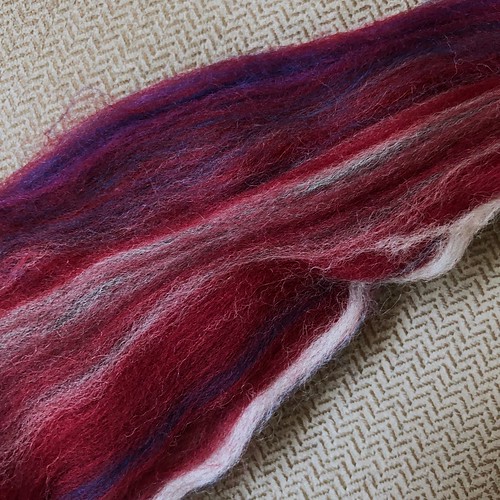
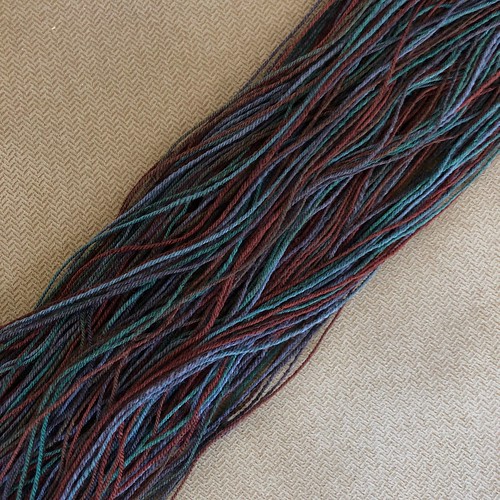
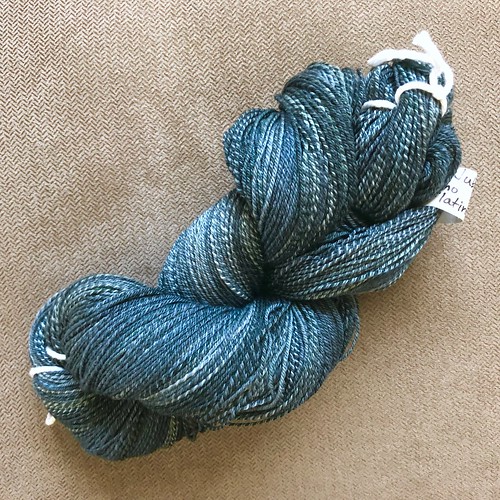
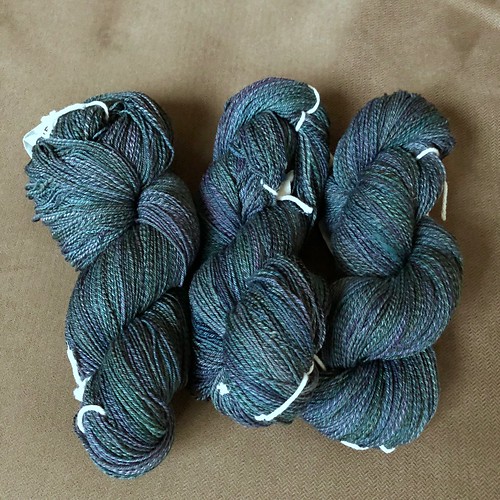
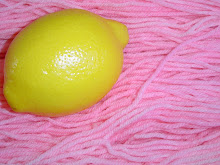






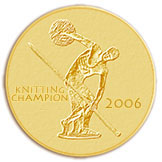


0 Comments:
Post a Comment
<< Home